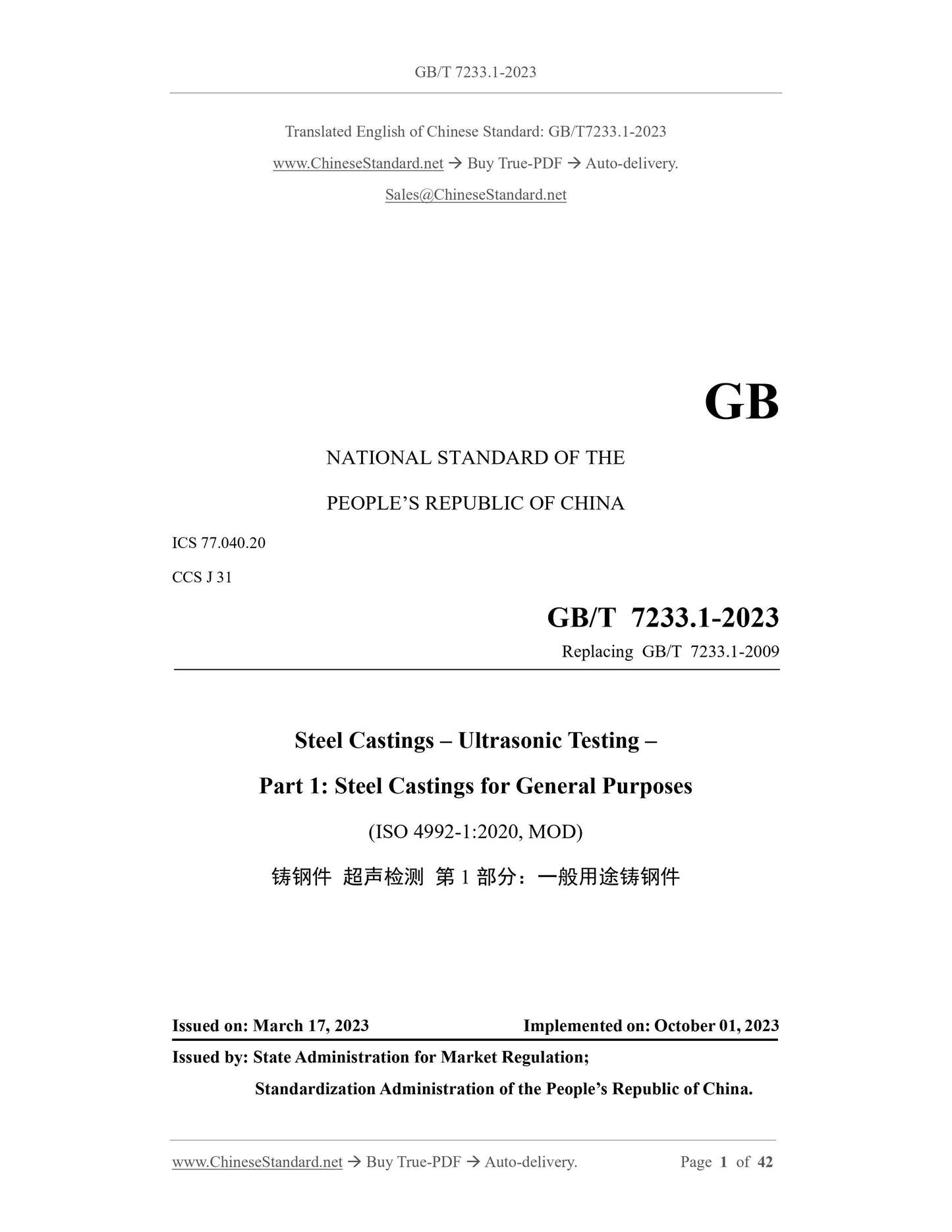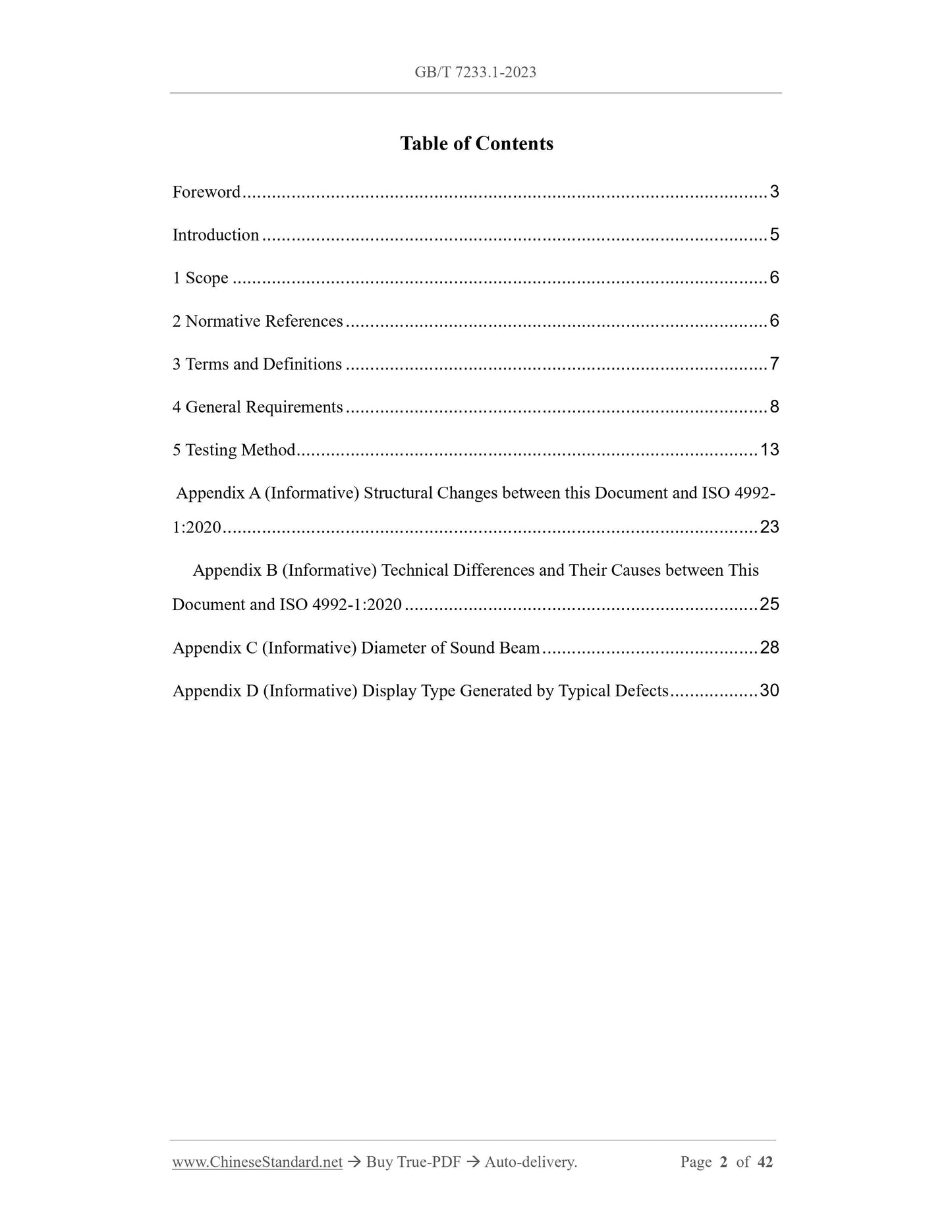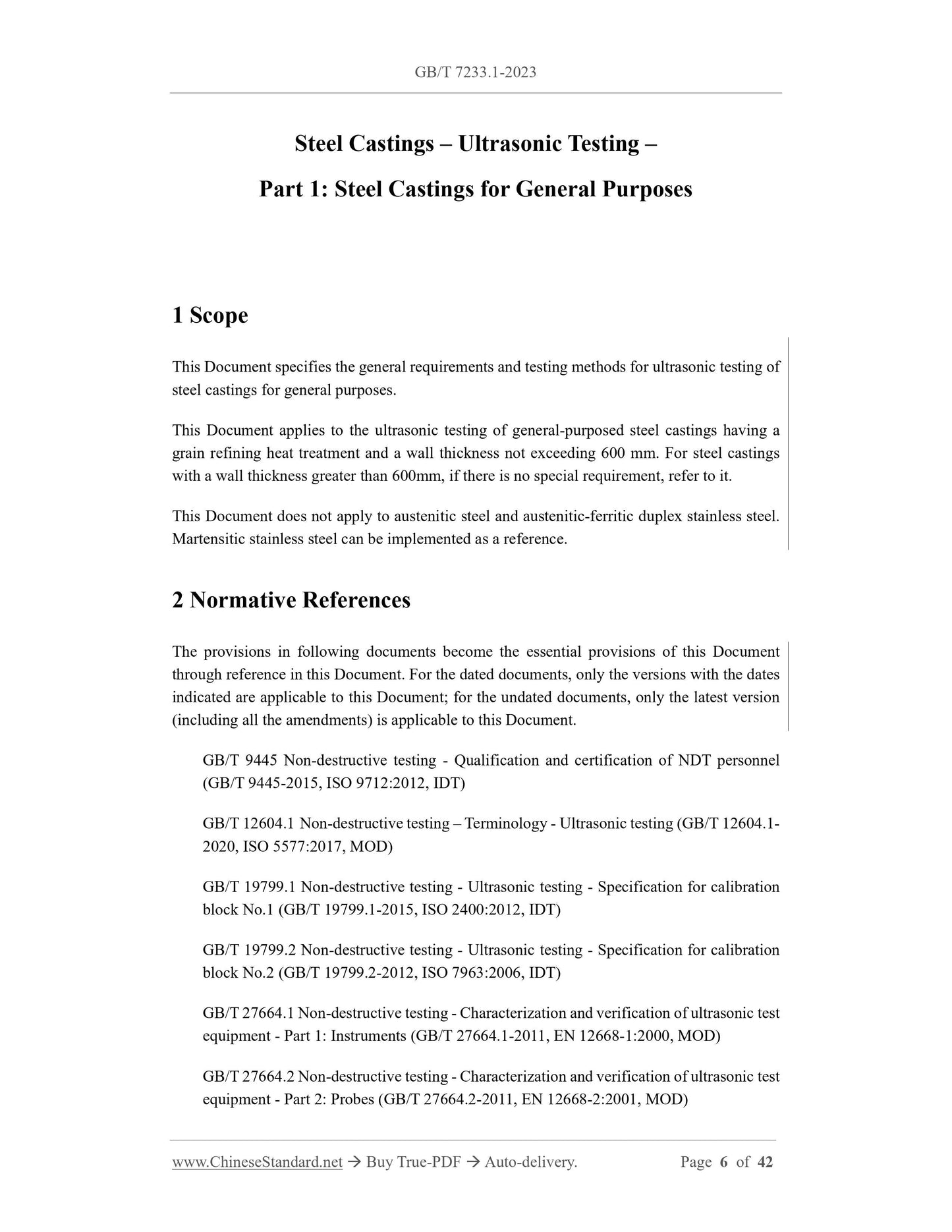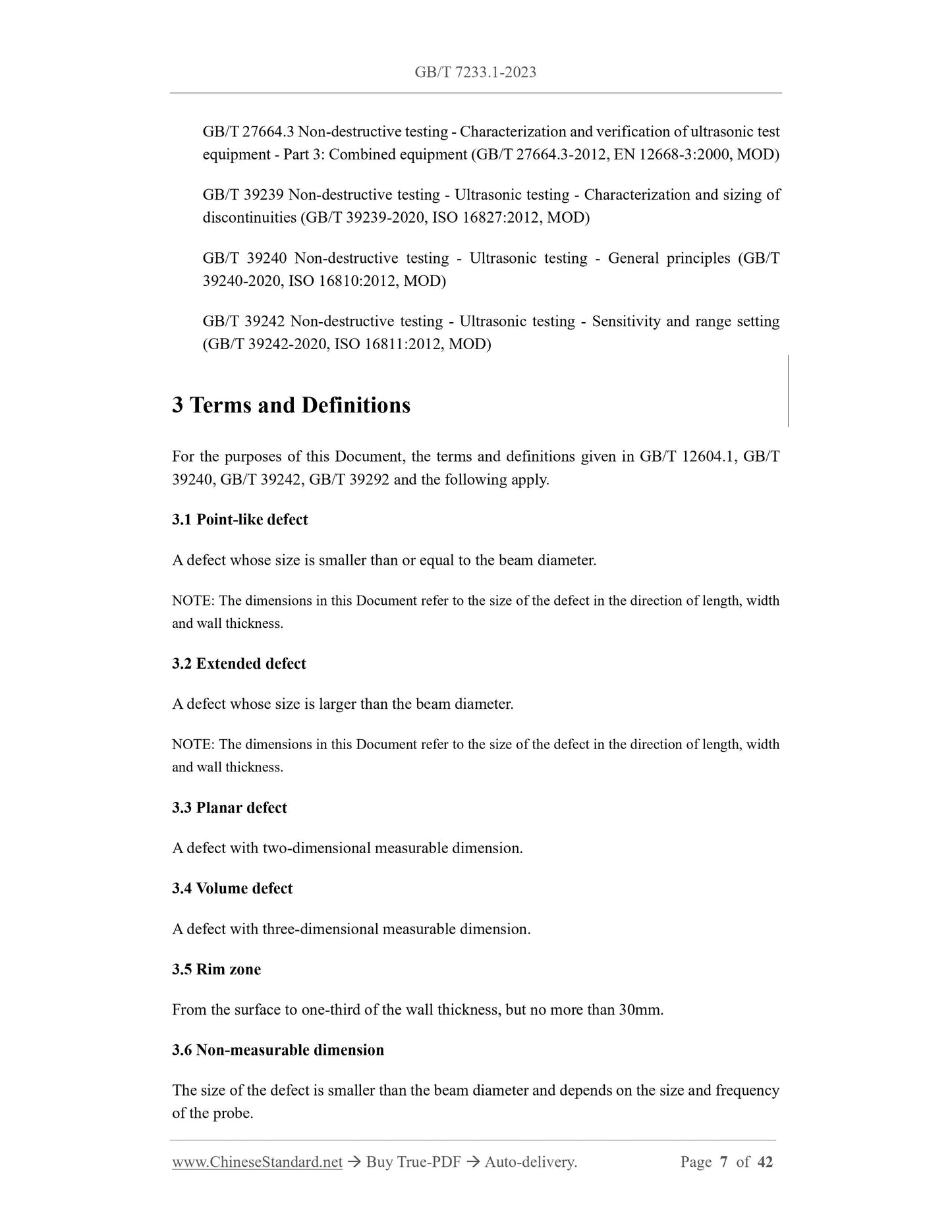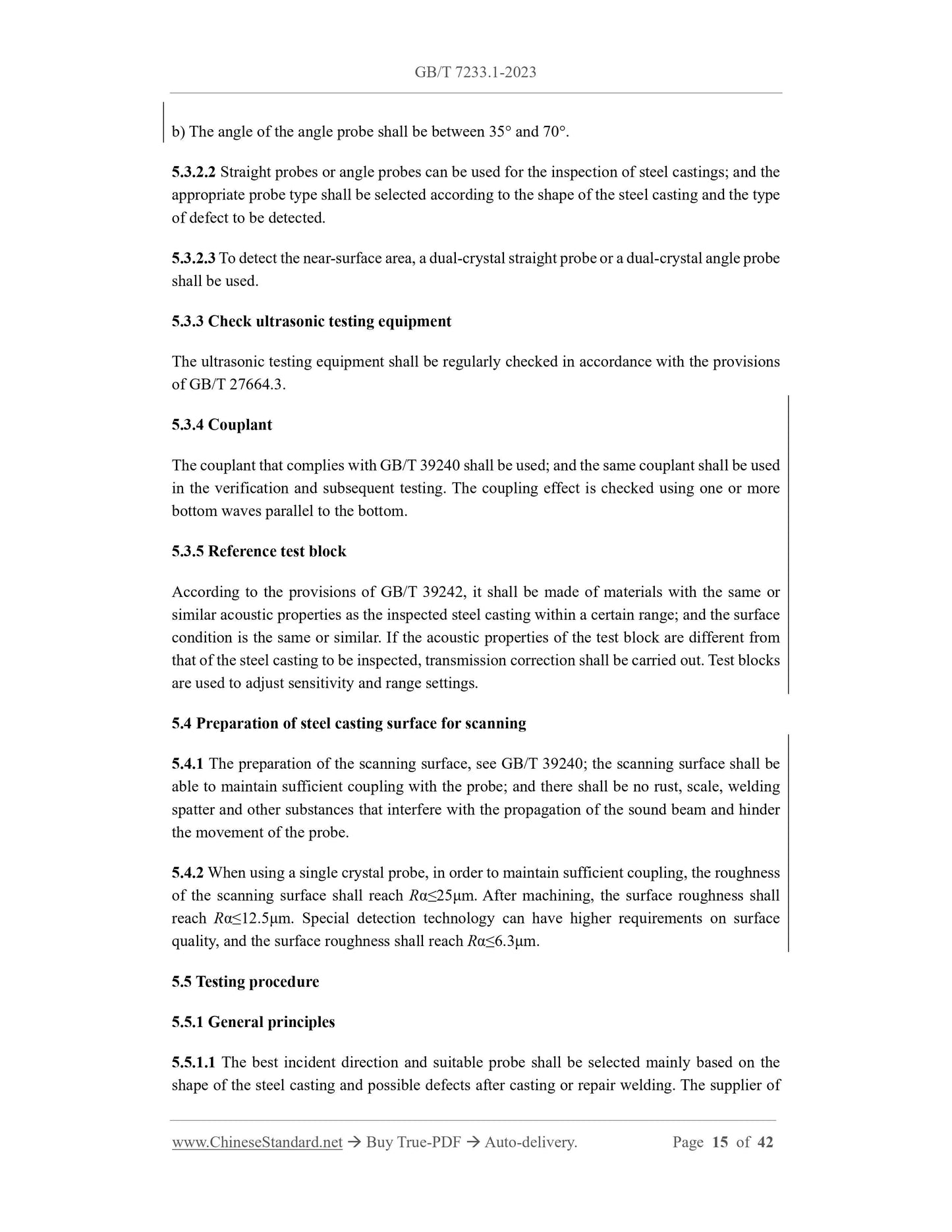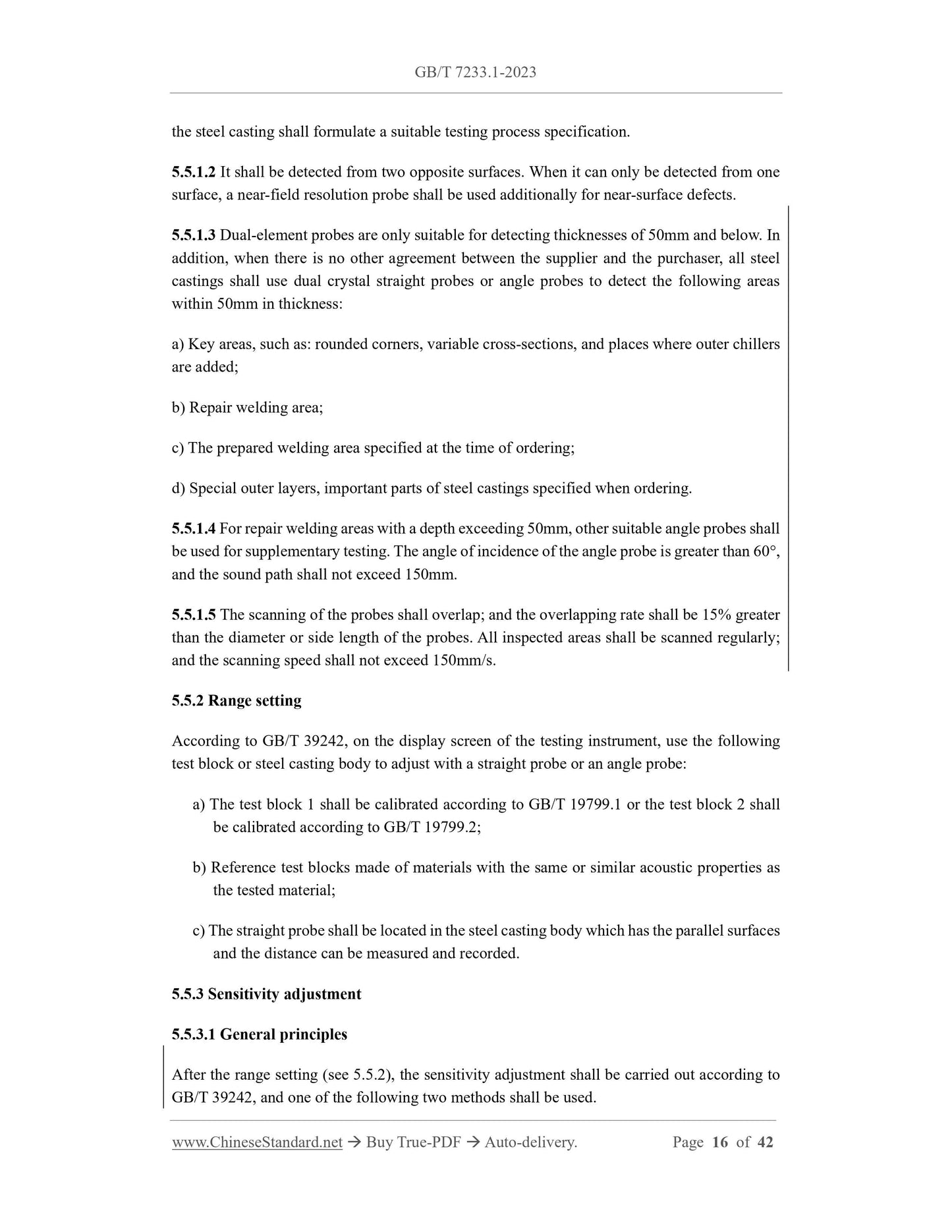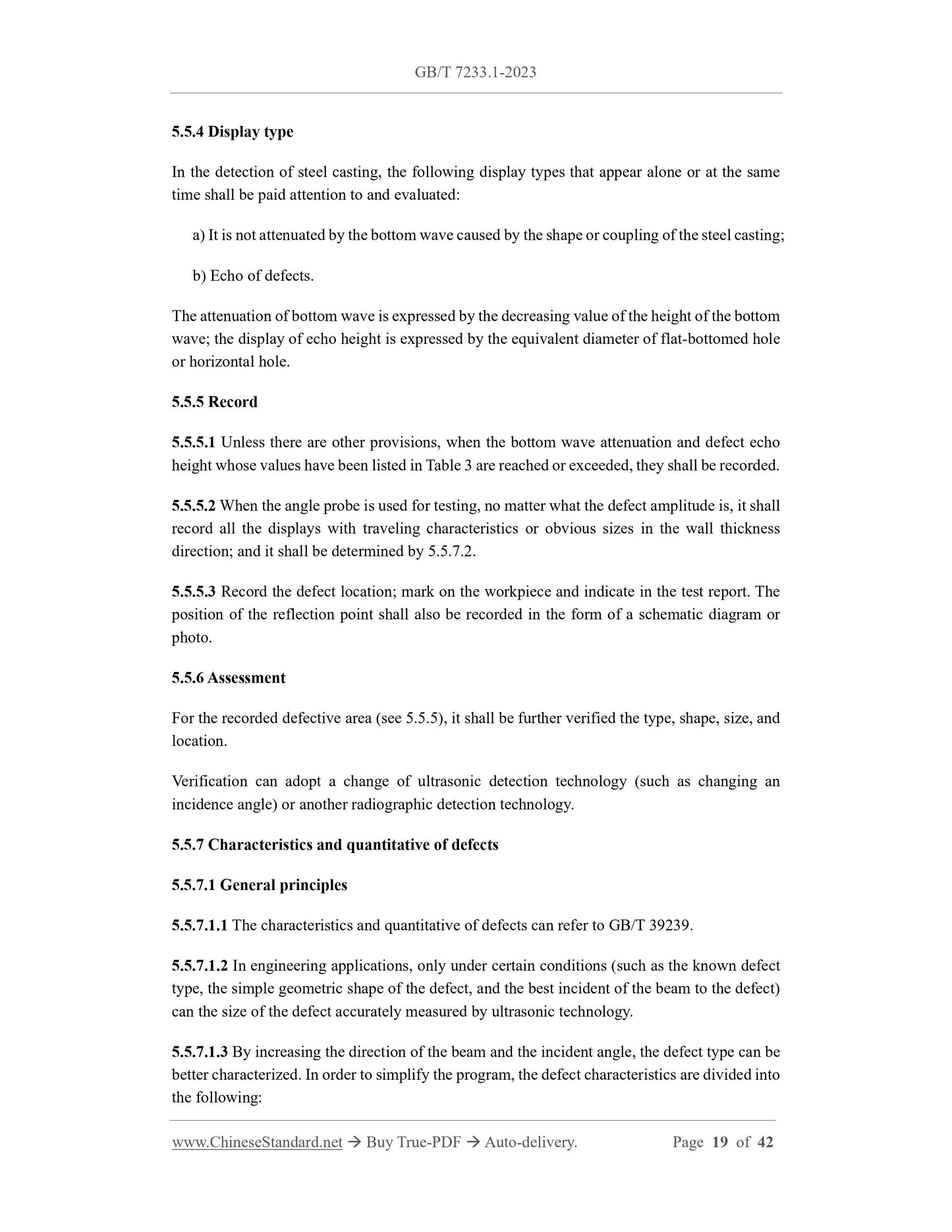PayPal, credit cards. Download editable-PDF & invoice in 1 second!
GB/T 7233.1-2023 English PDF (GBT7233.1-2023)
GB/T 7233.1-2023 English PDF (GBT7233.1-2023)
Precio habitual
$500.00 USD
Precio habitual
Precio de oferta
$500.00 USD
Precio unitario
/
por
Los gastos de envío se calculan en la pantalla de pago.
No se pudo cargar la disponibilidad de retiro
Delivery: 3 seconds. Download true-PDF + Invoice.
Get QUOTATION in 1-minute: Click GB/T 7233.1-2023
Historical versions: GB/T 7233.1-2023
Preview True-PDF (Reload/Scroll if blank)
GB/T 7233.1-2023: Steel castings -- Ultrasonic testing -- Part 1: Steel castings for general purposes
GB/T 7233.1-2023
GB
NATIONAL STANDARD OF THE
PEOPLE’S REPUBLIC OF CHINA
ICS 77.040.20
CCS J 31
Replacing GB/T 7233.1-2009
Steel Castings – Ultrasonic Testing –
Part 1: Steel Castings for General Purposes
(ISO 4992-1:2020, MOD)
ISSUED ON: MARCH 17, 2023
IMPLEMENTED ON: OCTOBER 01, 2023
Issued by: State Administration for Market Regulation;
Standardization Administration of the People’s Republic of China.
Table of Contents
Foreword ... 3
Introduction ... 5
1 Scope ... 6
2 Normative References ... 6
3 Terms and Definitions ... 7
4 General Requirements ... 8
5 Testing Method ... 13
Appendix A (Informative) Structural Changes between this Document and ISO 4992-
1:2020 ... 23
Appendix B (Informative) Technical Differences and Their Causes between This
Document and ISO 4992-1:2020 ... 25
Appendix C (Informative) Diameter of Sound Beam ... 28
Appendix D (Informative) Display Type Generated by Typical Defects ... 30
Steel Castings – Ultrasonic Testing –
Part 1: Steel Castings for General Purposes
1 Scope
This Document specifies the general requirements and testing methods for ultrasonic testing of
steel castings for general purposes.
This Document applies to the ultrasonic testing of general-purposed steel castings having a
grain refining heat treatment and a wall thickness not exceeding 600 mm. For steel castings
with a wall thickness greater than 600mm, if there is no special requirement, refer to it.
This Document does not apply to austenitic steel and austenitic-ferritic duplex stainless steel.
Martensitic stainless steel can be implemented as a reference.
2 Normative References
The provisions in following documents become the essential provisions of this Document
through reference in this Document. For the dated documents, only the versions with the dates
indicated are applicable to this Document; for the undated documents, only the latest version
(including all the amendments) is applicable to this Document.
GB/T 9445 Non-destructive testing - Qualification and certification of NDT personnel
(GB/T 9445-2015, ISO 9712:2012, IDT)
GB/T 12604.1 Non-destructive testing – Terminology - Ultrasonic testing (GB/T 12604.1-
2020, ISO 5577:2017, MOD)
GB/T 19799.1 Non-destructive testing - Ultrasonic testing - Specification for calibration
block No.1 (GB/T 19799.1-2015, ISO 2400:2012, IDT)
GB/T 19799.2 Non-destructive testing - Ultrasonic testing - Specification for calibration
block No.2 (GB/T 19799.2-2012, ISO 7963:2006, IDT)
GB/T 27664.1 Non-destructive testing - Characterization and verification of ultrasonic test
equipment - Part 1: Instruments (GB/T 27664.1-2011, EN 12668-1:2000, MOD)
GB/T 27664.2 Non-destructive testing - Characterization and verification of ultrasonic test
equipment - Part 2: Probes (GB/T 27664.2-2011, EN 12668-2:2001, MOD)
GB/T 27664.3 Non-destructive testing - Characterization and verification of ultrasonic test
equipment - Part 3: Combined equipment (GB/T 27664.3-2012, EN 12668-3:2000, MOD)
GB/T 39239 Non-destructive testing - Ultrasonic testing - Characterization and sizing of
discontinuities (GB/T 39239-2020, ISO 16827:2012, MOD)
GB/T 39240 Non-destructive testing - Ultrasonic testing - General principles (GB/T
39240-2020, ISO 16810:2012, MOD)
GB/T 39242 Non-destructive testing - Ultrasonic testing - Sensitivity and range setting
(GB/T 39242-2020, ISO 16811:2012, MOD)
3 Terms and Definitions
For the purposes of this Document, the terms and definitions given in GB/T 12604.1, GB/T
39240, GB/T 39242, GB/T 39292 and the following apply.
3.1 Point-like defect
A defect whose size is smaller than or equal to the beam diameter.
NOTE: The dimensions in this Document refer to the size of the defect in the direction of length, width
and wall thickness.
3.2 Extended defect
A defect whose size is larger than the beam diameter.
NOTE: The dimensions in this Document refer to the size of the defect in the direction of length, width
and wall thickness.
3.3 Planar defect
A defect with two-dimensional measurable dimension.
3.4 Volume defect
A defect with three-dimensional measurable dimension.
3.5 Rim zone
From the surface to one-third of the wall thickness, but no more than 30mm.
3.6 Non-measurable dimension
The size of the defect is smaller than the beam diameter and depends on the size and frequency
of the probe.
b) The angle of the angle probe shall be between 35° and 70°.
5.3.2.2 Straight probes or angle probes can be used for the inspection of steel castings; and the
appropriate probe type shall be selected according to the shape of the steel casting and the type
of defect to be detected.
5.3.2.3 To detect the near-surface area, a dual-crystal straight probe or a dual-crystal angle probe
shall be used.
5.3.3 Check ultrasonic testing equipment
The ultrasonic testing equipment shall be regularly checked in accordance with the provisions
of GB/T 27664.3.
5.3.4 Couplant
The couplant that complies with GB/T 39240 shall be used; and the same couplant shall be used
in the verification and subsequent testing. The coupling effect is checked using one or more
bottom waves parallel to the bottom.
5.3.5 Reference test block
According to the provisions of GB/T 39242, it shall be made of materials with the same or
similar acoustic properties as the inspected steel casting within a certain range; and the surface
condition is the same or similar. If the acoustic properties of the test block are different from
that of the steel casting to be inspected, transmission correction shall be carried out. Test blocks
are used to adjust sensitivity and range settings.
5.4 Preparation of steel casting surface for scanning
5.4.1 The preparation of the scanning surface, see GB/T 39240; the scanning surface shall be
able to maintain sufficient coupling with the probe; and there shall be no rust, scale, welding
spatter and other substances that interfere with the propagation of the sound beam and hinder
the movement of the probe.
5.4.2 When using a single crystal probe, in order to maintain sufficient coupling, the roughness
of the scanning surface shall reach Rα≤25μm. After machining, the surface roughness shall
reach Rα≤12.5μm. Special detection technology can have higher requirements on surface
quality, and the surface roughness shall reach Rα≤6.3μm.
5.5 Testing procedure
5.5.1 General principles
5.5.1.1 The best incident direction and suitable probe shall be selected mainly based on the
shape of the steel casting and possible defects after casting or repair welding. The supplier of
the steel casting shall formulate a suitable testing process specification.
5.5.1.2 It shall be detected from two opposite surfaces. When it can only be detected from one
surface, a near-field resolution probe shall be used additionally for near-surface defects.
5.5.1.3 Dual-element probes are only suitable for detecting thicknesses of 50mm and below. In
addition, when there is no other agreement between the supplier and the purchaser, all steel
castings shall use dual crystal straight probes or angle probes to detect the following areas
within 50mm in thickness:
a) Key areas, such as: rounded corners, variable cross-sections, and places where outer chillers
are added;
b) Repair welding area;
c) The prepared welding area specified at the time of ordering;
d) Special outer layers, important parts of steel castings specified when ordering.
5.5.1.4 For repair welding areas wit...
Get QUOTATION in 1-minute: Click GB/T 7233.1-2023
Historical versions: GB/T 7233.1-2023
Preview True-PDF (Reload/Scroll if blank)
GB/T 7233.1-2023: Steel castings -- Ultrasonic testing -- Part 1: Steel castings for general purposes
GB/T 7233.1-2023
GB
NATIONAL STANDARD OF THE
PEOPLE’S REPUBLIC OF CHINA
ICS 77.040.20
CCS J 31
Replacing GB/T 7233.1-2009
Steel Castings – Ultrasonic Testing –
Part 1: Steel Castings for General Purposes
(ISO 4992-1:2020, MOD)
ISSUED ON: MARCH 17, 2023
IMPLEMENTED ON: OCTOBER 01, 2023
Issued by: State Administration for Market Regulation;
Standardization Administration of the People’s Republic of China.
Table of Contents
Foreword ... 3
Introduction ... 5
1 Scope ... 6
2 Normative References ... 6
3 Terms and Definitions ... 7
4 General Requirements ... 8
5 Testing Method ... 13
Appendix A (Informative) Structural Changes between this Document and ISO 4992-
1:2020 ... 23
Appendix B (Informative) Technical Differences and Their Causes between This
Document and ISO 4992-1:2020 ... 25
Appendix C (Informative) Diameter of Sound Beam ... 28
Appendix D (Informative) Display Type Generated by Typical Defects ... 30
Steel Castings – Ultrasonic Testing –
Part 1: Steel Castings for General Purposes
1 Scope
This Document specifies the general requirements and testing methods for ultrasonic testing of
steel castings for general purposes.
This Document applies to the ultrasonic testing of general-purposed steel castings having a
grain refining heat treatment and a wall thickness not exceeding 600 mm. For steel castings
with a wall thickness greater than 600mm, if there is no special requirement, refer to it.
This Document does not apply to austenitic steel and austenitic-ferritic duplex stainless steel.
Martensitic stainless steel can be implemented as a reference.
2 Normative References
The provisions in following documents become the essential provisions of this Document
through reference in this Document. For the dated documents, only the versions with the dates
indicated are applicable to this Document; for the undated documents, only the latest version
(including all the amendments) is applicable to this Document.
GB/T 9445 Non-destructive testing - Qualification and certification of NDT personnel
(GB/T 9445-2015, ISO 9712:2012, IDT)
GB/T 12604.1 Non-destructive testing – Terminology - Ultrasonic testing (GB/T 12604.1-
2020, ISO 5577:2017, MOD)
GB/T 19799.1 Non-destructive testing - Ultrasonic testing - Specification for calibration
block No.1 (GB/T 19799.1-2015, ISO 2400:2012, IDT)
GB/T 19799.2 Non-destructive testing - Ultrasonic testing - Specification for calibration
block No.2 (GB/T 19799.2-2012, ISO 7963:2006, IDT)
GB/T 27664.1 Non-destructive testing - Characterization and verification of ultrasonic test
equipment - Part 1: Instruments (GB/T 27664.1-2011, EN 12668-1:2000, MOD)
GB/T 27664.2 Non-destructive testing - Characterization and verification of ultrasonic test
equipment - Part 2: Probes (GB/T 27664.2-2011, EN 12668-2:2001, MOD)
GB/T 27664.3 Non-destructive testing - Characterization and verification of ultrasonic test
equipment - Part 3: Combined equipment (GB/T 27664.3-2012, EN 12668-3:2000, MOD)
GB/T 39239 Non-destructive testing - Ultrasonic testing - Characterization and sizing of
discontinuities (GB/T 39239-2020, ISO 16827:2012, MOD)
GB/T 39240 Non-destructive testing - Ultrasonic testing - General principles (GB/T
39240-2020, ISO 16810:2012, MOD)
GB/T 39242 Non-destructive testing - Ultrasonic testing - Sensitivity and range setting
(GB/T 39242-2020, ISO 16811:2012, MOD)
3 Terms and Definitions
For the purposes of this Document, the terms and definitions given in GB/T 12604.1, GB/T
39240, GB/T 39242, GB/T 39292 and the following apply.
3.1 Point-like defect
A defect whose size is smaller than or equal to the beam diameter.
NOTE: The dimensions in this Document refer to the size of the defect in the direction of length, width
and wall thickness.
3.2 Extended defect
A defect whose size is larger than the beam diameter.
NOTE: The dimensions in this Document refer to the size of the defect in the direction of length, width
and wall thickness.
3.3 Planar defect
A defect with two-dimensional measurable dimension.
3.4 Volume defect
A defect with three-dimensional measurable dimension.
3.5 Rim zone
From the surface to one-third of the wall thickness, but no more than 30mm.
3.6 Non-measurable dimension
The size of the defect is smaller than the beam diameter and depends on the size and frequency
of the probe.
b) The angle of the angle probe shall be between 35° and 70°.
5.3.2.2 Straight probes or angle probes can be used for the inspection of steel castings; and the
appropriate probe type shall be selected according to the shape of the steel casting and the type
of defect to be detected.
5.3.2.3 To detect the near-surface area, a dual-crystal straight probe or a dual-crystal angle probe
shall be used.
5.3.3 Check ultrasonic testing equipment
The ultrasonic testing equipment shall be regularly checked in accordance with the provisions
of GB/T 27664.3.
5.3.4 Couplant
The couplant that complies with GB/T 39240 shall be used; and the same couplant shall be used
in the verification and subsequent testing. The coupling effect is checked using one or more
bottom waves parallel to the bottom.
5.3.5 Reference test block
According to the provisions of GB/T 39242, it shall be made of materials with the same or
similar acoustic properties as the inspected steel casting within a certain range; and the surface
condition is the same or similar. If the acoustic properties of the test block are different from
that of the steel casting to be inspected, transmission correction shall be carried out. Test blocks
are used to adjust sensitivity and range settings.
5.4 Preparation of steel casting surface for scanning
5.4.1 The preparation of the scanning surface, see GB/T 39240; the scanning surface shall be
able to maintain sufficient coupling with the probe; and there shall be no rust, scale, welding
spatter and other substances that interfere with the propagation of the sound beam and hinder
the movement of the probe.
5.4.2 When using a single crystal probe, in order to maintain sufficient coupling, the roughness
of the scanning surface shall reach Rα≤25μm. After machining, the surface roughness shall
reach Rα≤12.5μm. Special detection technology can have higher requirements on surface
quality, and the surface roughness shall reach Rα≤6.3μm.
5.5 Testing procedure
5.5.1 General principles
5.5.1.1 The best incident direction and suitable probe shall be selected mainly based on the
shape of the steel casting and possible defects after casting or repair welding. The supplier of
the steel casting shall formulate a suitable testing process specification.
5.5.1.2 It shall be detected from two opposite surfaces. When it can only be detected from one
surface, a near-field resolution probe shall be used additionally for near-surface defects.
5.5.1.3 Dual-element probes are only suitable for detecting thicknesses of 50mm and below. In
addition, when there is no other agreement between the supplier and the purchaser, all steel
castings shall use dual crystal straight probes or angle probes to detect the following areas
within 50mm in thickness:
a) Key areas, such as: rounded corners, variable cross-sections, and places where outer chillers
are added;
b) Repair welding area;
c) The prepared welding area specified at the time of ordering;
d) Special outer layers, important parts of steel castings specified when ordering.
5.5.1.4 For repair welding areas wit...
Share
